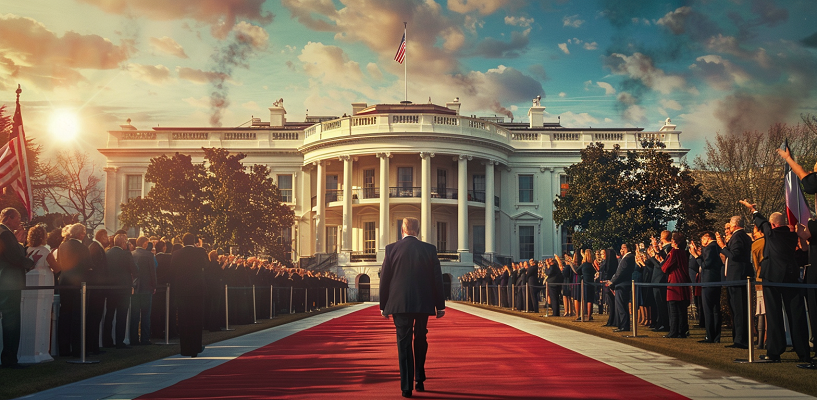Presidential Election

“““American citizens cast their ballots for president and vice president in the general election every four years, on the first Tuesday following the first Monday in November.
There are 538 Electors in the Electoral College. The procedure of the Electoral College consists of 3 steps: Elector selection, meeting of Electors to cast votes for the president and vice president, and Congressional tallying of the electors’ votes.
Elector Selection: The Census determines how “Electoral votes” (Electors) are distributed across the States. According to the number of Senators and Representatives in its U.S. Congressional delegation, each State receives “2 votes for its senators in the U.S. Senate” in addition to a “number of votes based on the number of Congressional districts” it has. Each Congressional district represents a geographical area within the State and is represented by one member in the “U.S. House of Representatives.”
Each State’s political parties select slates of prospective Electors at some point before the general election. Those on these slates are dedicated to backing the presidential and vice-presidential candidates of their party in the Electoral College in the event that they win the State’s popular vote.
Voters choose their State’s Electors when they cast ballots for the presidential candidate of their choice in each State. Depending on the election protocols and ballot types used in each State, the names of the Electors may or may not appear on the ballot, beneath the names of the presidential candidates.
With the exception of Nebraska and Maine, the slate of Electors linked to the victorious presidential candidate are nominated as the State’s Electors. In both Maine and Nebraska, “the victor presidential candidate of the State” gets two Electors as well as “the victor of each Congressional district” (it may be the same, the State victor, or a new victor) gets one Elector. This approach allows Maine and Nebraska to award Electors to several presidential contenders.
The majority of States use “winner-take-all” electoral systems, meaning that the presidential candidate who wins the State’s popular vote receives all of the State Electors.
Meeting of Electors: The Electors gather in their individual States, to vote for the president and vice president of the United States, on the first Tuesday following the second Wednesday in December.
Electors, in a December meeting, are not obligated by the Constitution or federal law, to cast their vote in accordance with the outcomes of their State’s “popular vote” (commonly referred to as the general election). However, several States mandate that Electors cast their vote in accordance with the results of the popular vote.
Tallying of the Electors’ Votes: To tally the electoral votes, Congress convenes in a joint session in the “House of Representatives” on January 6. As the Senate’s President, the vice president uncovers each state’s vote in alphabetical order and gives them to the designated Tellers, who then declare the outcomes aloud.
The Senate’s President then asks if there are any objections. If an objection is accepted then the House and Senate proceed to their respective chambers “to evaluate the genuineness of any objection” (in accordance with 3 U.S.C).
The Senate’s President announces who, if anyone, has been elected President and Vice President of the United States following the recording and tallying of all the votes.
On January 20, the year after the general election, the President-elect takes the oath of office and as the head of U.S.
The “National Archives and Records Administration” (NARA) includes the “Office of the Federal Register” (OFR), which is responsible for coordinating some “Electoral College” duties between the States and Congress on behalf of the US Archivist.
Those who are registered to vote in the general election for president can: “cast a vote despite not having participated in their state’s primary elections,” “vote for any presidential candidate, irrespective of their party affiliation or previous voting history.”
As of information fetched in 2024, all American citizens over the age of eighteen are guaranteed the right to vote in “federal (national), state, and local” elections under the U.S. Constitution””” — according to information found at “usa.gov/election” and “archives.gov/electoral-college/about”.
According to the “U.S. Constitution,” the president must to be a natural-born citizen of the country, be at least 35 years old and have lived in the US for the previous 14 years. The vice president needs to fulfill the same requirements and haven’t held the president post for two terms.
Republicans and Democrats each host a national convention in the summer of a “presidential election” year, during which they put forward the names of candidates for president and vice president and establish a “platform” of principles. Party nominees may use public funds to run for president, but they may not use public funds to seek nominations in the “primaries or caucuses.”
If a candidate for “president, senator, or representative” is raising money independently, federal law defines the manner and source of contributions. It also caps the amount that each individual donor may provide. The law makes sure that the public and media are aware of the donors to a particular politician. Since 2010, candidates have been able to fund their campaigns with an unrestricted amount of their own funds.
Presidential Election Facts -
It is quite likely that the presidential candidate with the highest “popular vote” will lose the Electoral College in a multi-candidate election, where the contenders have considerable regional appeal. This occurred three times in the 1800s, in 2000, and in 2016. In a campaign with two candidates, that is less likely to happen.
The presidential election shifts from the “Electoral College” to Congress if no candidate wins a majority of electoral votes. Out of the “3 presidential contenders” (with the highest number of Electoral votes) the “House of Representatives” chooses the president. Every State delegation is allowed one vote, and each State sets its own procedures for casting its vote. To win, a candidate needs to gain a majority of the States’ votes (at least 26). Meanwhile, in the Senate, the vice president is chosen from the 2 candidates with the most Electoral votes. One vote is cast for vice president by each Senator (the “District of Columbia” does not vote because it is not a State and does not have Senators). To be elected, a candidate needs to get at least 51 votes (a majority of Senators).
In the event that a State’s popular vote results in a tie between the presidential candidates, the method by which the tie would be broken “would be determined by State legislation” (in effect prior to the “general election”). In order to appoint the Electors no later than 6 days prior to the Electors’ meeting, the 2022 “Electoral Count Reform Act” allowed for expedited court proceedings in the event that one or more candidates challenges the election results.
The ability to vote for president is not granted to citizens of “U.S. Territories” (Guam, Puerto Rico, American Samoa, the U.S. Virgin Islands, and the U.S. Minor Outlying Islands) through the Electoral College procedure. Citizens of the “U.S. Territories” are not eligible to vote in the presidential election unless they are residents of a U.S. State or the “D.C.”
As to Section 3 of the 20th Amendment, in the event that the President-elect is unable to qualify prior to inauguration, the Vice President-elect will assume the role of President until a President has been qualified.
Section 3 of the 20th Amendment states that the Vice President-elect becomes President in the event that the victorious presidential candidate “passes away” or “becomes disabled” “between the inauguration and the Congressional counting of Electoral votes.”
Federal office elections take place every even-numbered year. Since 1800, the President has had the official residence and office in the White House in “Washington, D.C.”
The United States Constitution’s “22nd Amendment,” which forbids anybody from serving as president more than twice, was enacted in 1951. Since 1852, there has been a Republican or a Democrat as president.
Presidential Election Results -
Details regarding the presidential election, election year, candidates, parties, votes cast, and the eventual victor.
| Year | Party | Presidential | Vice Presidential | Electoral Vote | Popular Vote |
|---|---|---|---|---|---|
| 2024 | Democratic | Kamala Harris | Tim Walz | 226 | |
| Republican (Winner) | Donald J. Trump | J.D. Vance | 312 | ||
| 2020 | Democratic (Winner) | Joseph R. Biden | Kamala Harris | 306 | 51.31% |
| Republican | Donald Trump | Mike Pence | 232 | 46.86% | |
| 2016 | Democratic | Hillary Clinton | Tim Kaine | 232 | 48.2% |
| Republican (Winner) | Donald Trump | Mike Pence | 306 | 46.2% | |
| 2012 | Democratic (Winner) | Barack Obama | Joseph Biden | 332 | 51.1% |
| Republican | Mitt Romney | Paul Ryan | 206 | 47.2% | |
| 2008 | Democratic (Winner) | Barack Obama | Joseph Biden | 365 | 52.9% |
| Republican | John McCain | Sarah Palin | 173 | 45.7% | |
| 2004 | Democratic | John Kerry | John Edwards | 251 | 48.3% |
| Republican (Winner) | George W. Bush | Richard Cheney | 286 | 50.7% | |
| 2000 | Democratic | Albert Gore, Jr. | Joseph Lieberman | 266 | 48.4% |
| Republican (Winner) | George W. Bush | Richard Cheney | 271 | 47.9% | |
| 1996 | Democratic (Winner) | William J. Clinton | Albert Gore, Jr. | 379 | 49.2% |
| Republican | Robert Dole | Jack Kemp | 159 | 40.7% | |
| 1992 | Democratic (Winner) | William J. Clinton | Albert Gore, Jr. | 370 | 43.0% |
| Republican | George Bush | Dan Quayle | 168 | 37.4% | |
| 1988 | Democratic | Michael Dukakis | Lloyd Bentsen | 111 | 45.6% |
| Republican (Winner) | George Bush | Dan Quayle | 426 | 53.4% |
* table Data obtained from “presidency.ucsb.edu/statistics/elections/”.
That’s all friends.

